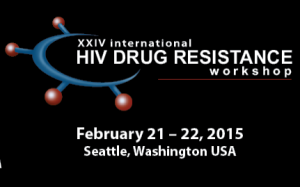Drug resistance in children after PMTCT and early treatment
24 March 2015. Related: Conference reports, Pregnancy, Paediatric care, Drug resistance, Intl Drug Resistance Workshop 24 Seattle 2015.
 Simon Collins, HIV i-Base
Simon Collins, HIV i-Base
With fewer treatment options, especially in resource-limited settings, two studies were notable for highlighting the high rates of drug resistance in young children and that this is often compounded by transmitted resistance.
Resistance test results were presented for a cohort of children in Burkino Faso and Côte d’Ivoire aged < 2 years who were enrolled from September 2011 to January 2013 on first-line lopinavir/ritonavir based combinations, whose treatment was failing (defined as viral load >1000 copies/mL at 12 months). [1]
Of 156 children enrolled, 28 (18%) had virologic failure. Median viral load was 5 million copies/mL (range 4.4 to 8.2 log copies/mL). All samples were amplified and 21/28 (75%) had resistance to at least one drug. Among those, 11/21 (52%) were primary mutations acquired during therapy and 5 (25%) attributed to PMTCT intervention. The most common mutations were M184 (57%), K103N (18%), Y181C (11%) and E138G (3.6%). One sample had 3-class resistance to NRTI, NNRTI and PI.
The impact of ARV exposure as part of PMTCT on drug resistance in children who became infected was reported in a cohort of children from Mozambique. Results were from dry blood spot samples that had formed their initial diagnosis.
Of 496 samples collected, 429 (86%) were successfully genotyped, 97% were subtype C.
NNRTI resistance (Y181C, E138A and G190A) was present in 52.9% and NRTI resistance in 11.4% (mainly M184V). Maternal use of ART was significantly associated with NRTI resistance, (OR 2.41; p< 0.05).
Comment
A poster from the ARROW study at CROI 2014, [3] joins other studies in older children [4, 5] that suggest perinatally acquired resistance from nevirapine exposure might not necessarily translate into poor response to nevirapine-based treatment.
References:
Unless stated otherwise, references are to the Programme and Abstracts of the XXIV International HIV Drug Resistance Workshop, 21-22 February 2015, Seattle, Washington.
- Toni TA et al. Virologic failure and profiles of resistance after 12 months of antiretroviral lopinavir-based therapy in children early treated before the age of two, in West Africa. Abstract 33.
- Ismael N et al. Primary drug resistance among children infected with HIV-1 in Mozambique: impact of maternal and neonatal prophylaxis. Abstract 78.
- Musoke P et al. SdNVP exposure and ART response in children <3 years initiating ART in the ARROW trial. CROI, March 3-6, 2014, Boston. Poster abstract 894.
http://www.croiconference.org/sessions/sdnvp-exposure-and-art-response-children - Lindsey JC et al. Predictors of virologic and clinical response to nevirapine versus lopinavir/ritonavir-based antiretroviral therapy in young children with and without prior nevirapine exposure for the prevention of mother-to-child HIV iransmission. The Pediatric Infectious Disease Journal 2014 (33):846-854.
- Musoke P et al. Response to antiretroviral therapy in HIV-infected Ugandan children exposed and not exposed to single-dose nevirapine at birth. Journal of AIDS 2009 (52):560-568.

